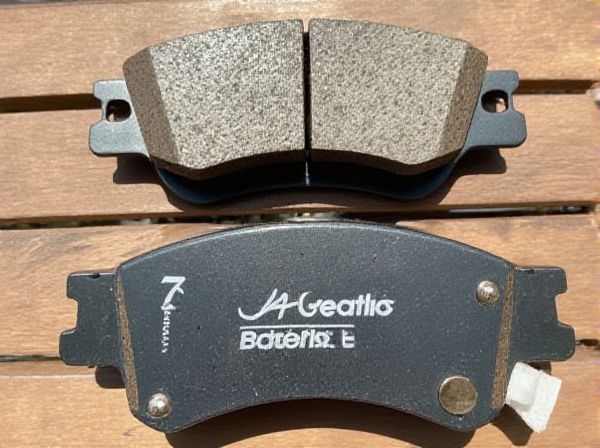
Photo illustration: Non-Asbestos Organic Pad vs Metallic Pad
Non-asbestos organic pads provide quieter braking and less rotor wear compared to metallic pads, making them ideal for everyday driving and vehicles requiring gentle stopping power. Metallic pads offer superior heat dissipation and durability, excelling in high-performance or heavy-duty applications where consistent braking under extreme conditions is needed. Your choice depends on balancing noise level, rotor longevity, and braking performance to suit your driving style.
Table of Comparison
| Feature | Non-Asbestos Organic Pad (NAO) | Metallic Pad |
|---|---|---|
| Material Composition | Organic fibers, resins, fillers, and non-asbestos materials | Metallic fibers, steel, iron, and other metals blended with friction modifiers |
| Brake Performance | Quiet operation, softer bite, moderate stopping power | High friction, strong bite, effective under high temperatures |
| Heat Dissipation | Lower heat resistance, prone to fade under heavy braking | Excellent heat dissipation, resistant to brake fade |
| Lifespan | Shorter life span due to softer materials | Longer lifespan, more durable under extreme conditions |
| Brake Rotor Wear | Minimal rotor wear | Higher rotor wear due to abrasive metallic content |
| Noise Level | Generally quiet | May produce squealing and noise |
| Cost | More affordable | Higher cost |
| Ideal Use | Daily driving, light braking conditions | Performance driving, heavy-duty and high-speed braking |
Introduction to Brake Pad Materials
Non-asbestos organic (NAO) brake pads are composed of synthetic fibers, fillers, and binders, offering quieter braking and reduced rotor wear compared to metallic pads. Metallic brake pads contain steel, copper, or iron particles, providing superior heat dissipation and durability ideal for high-performance or heavy-duty applications. Understanding the material composition is essential for selecting the appropriate brake pad based on driving conditions and performance requirements.
What Are Non-Asbestos Organic (NAO) Pads?
Non-Asbestos Organic (NAO) pads are brake pads made from organic materials such as fibers, resins, and fillers, designed to provide quieter braking with less wear on rotors. These pads contain no asbestos, reducing health risks and environmental impact while offering smooth braking performance primarily suited for everyday driving conditions. Compared to metallic pads, NAO pads typically generate less noise and dust but may have lower heat resistance and durability under high-performance or heavy-duty use.
Key Features of Metallic Brake Pads
Metallic brake pads are composed of a durable blend of metals such as copper, steel, and iron, offering superior heat dissipation and enhanced braking performance under high-temperature conditions. Their robust composition results in greater resistance to wear and longer lifespan compared to non-asbestos organic pads, making them ideal for heavy-duty and high-speed applications. The increased friction coefficient of metallic pads provides reliable stopping power and improved control, especially in demanding driving environments.
Performance Comparison: NAO vs Metallic Pads
Non-Asbestos Organic (NAO) pads offer quieter braking and reduced rotor wear due to their softer composition, making them ideal for everyday driving and light-duty applications. Metallic pads provide superior heat dissipation and durability, resulting in enhanced performance under high-stress conditions such as aggressive driving or heavy loads. The choice between NAO and metallic pads hinges on balancing noise levels, braking consistency, and longevity according to specific vehicle demands.
Durability and Lifespan Differences
Non-asbestos organic (NAO) pads provide excellent initial bite and quieter operation but typically exhibit shorter durability and lifespan compared to metallic pads, especially under high-temperature or heavy-load conditions. Metallic pads, composed of metal fibers and compounds, offer superior heat resistance and longer wear life, making them ideal for performance and heavy-duty braking applications. The enhanced thermal conductivity of metallic pads helps prevent glazing and maintains consistent stopping power over extended periods, whereas NAO pads may degrade faster due to resin breakdown and fading.
Noise and Comfort Factors
Non-asbestos organic pads generate less noise and offer superior comfort due to their softer materials and better vibration absorption compared to metallic pads. Metallic pads tend to produce more squealing sounds under heavy braking and may cause increased pedal feedback, resulting in reduced driving comfort. Noise reduction and smoother braking feel make non-asbestos organic pads ideal for everyday driving focused on comfort.
Environmental and Health Impacts
Non-asbestos organic (NAO) pads offer lower environmental impact by avoiding the harmful dust and fibers linked to asbestos, reducing respiratory risks for workers and end-users. Metallic pads, while durable and effective in high-temperature applications, can generate metal dust during wear that may pose inhalation hazards and require proper disposal to prevent soil contamination. Choosing NAO pads supports sustainable manufacturing practices and promotes safer air quality in automotive and industrial braking systems.
Cost Analysis: NAO vs Metallic Pads
Non-Asbestos Organic (NAO) brake pads generally have a lower initial cost compared to metallic pads, making them a more budget-friendly choice for everyday driving. However, metallic pads tend to offer better durability and heat resistance, which can translate to longer replacement intervals and reduced long-term maintenance expenses. When evaluating cost efficiency, the choice between NAO and metallic pads depends on balancing upfront affordability with lifespan and performance requirements.
Best Applications for Each Brake Pad Type
Non-asbestos organic (NAO) brake pads excel in passenger vehicles and light trucks due to their low noise, gentle rotor wear, and effective performance under moderate temperatures. Metallic brake pads are ideal for high-performance and heavy-duty applications, such as sports cars and commercial vehicles, offering superior heat dissipation, durability, and braking power under extreme conditions. Choosing NAO pads benefits everyday driving comfort and rotor longevity, whereas metallic pads ensure consistent braking performance in demanding environments.
Choosing the Right Brake Pad for Your Vehicle
Non-asbestos organic (NAO) brake pads offer quieter operation and less rotor wear, making them suitable for everyday city driving and vehicles with lighter braking demands. Metallic brake pads provide superior heat dissipation and improved braking performance under high-stress conditions, ideal for high-performance or heavy-duty vehicles. Selecting the right brake pad involves considering vehicle type, driving habits, and performance requirements to balance durability, noise level, and stopping power effectively.
 caratoz.com
caratoz.com